On the Road is a weekday feature spotlighting reader photo submissions.
From the exotic to the familiar, whether you’re traveling or in your own backyard, we would love to see the world through your eyes.
Albatrossity
In mid-October, when COVID-weariness and ZOOM-aversion seemed to be peaking (how little we knew then), Elizabeth and I made another 6-hour trip to the Hutton Niobrara Ranch Wildlife Sanctuary in far north-central Nebraska. Even though Kansas and Nebraska were hot zones for COVID at the time, we can make this trip, stay a few days at the guest house where we can cook all of our own food, and get back without seeing anyone else except at the gas station on the way and way back. I had never seen fall in the Sandhills of Nebraska, and Elizabeth was anxious to get out of the house, so we headed north. Here are some images from that trip; there will be another batch next week as well.
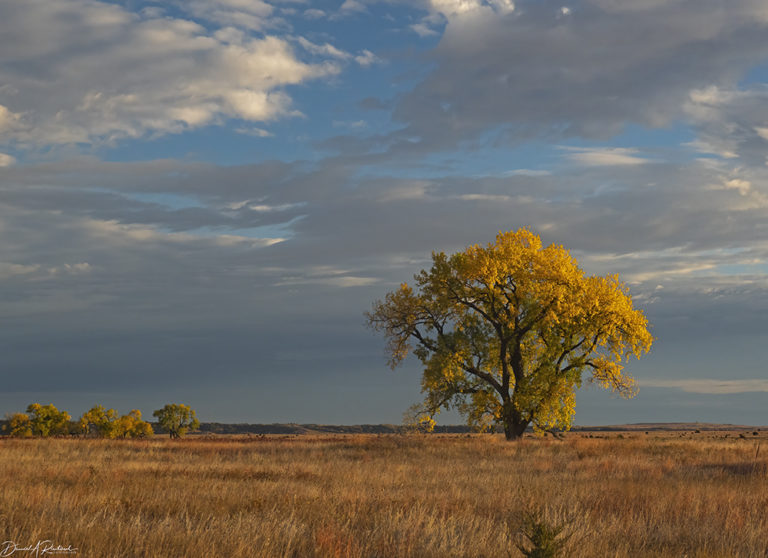
The iconic tree of the Great Plains is the Plains Cottonwood (Populus deltoides), and this magnificent specimen was collecting the early morning light on the sanctuary. It was surrounded by deep red Staghorn Sumac plants (Rhus typhina), which were quite stunning in their own right if you got close enough to see them.
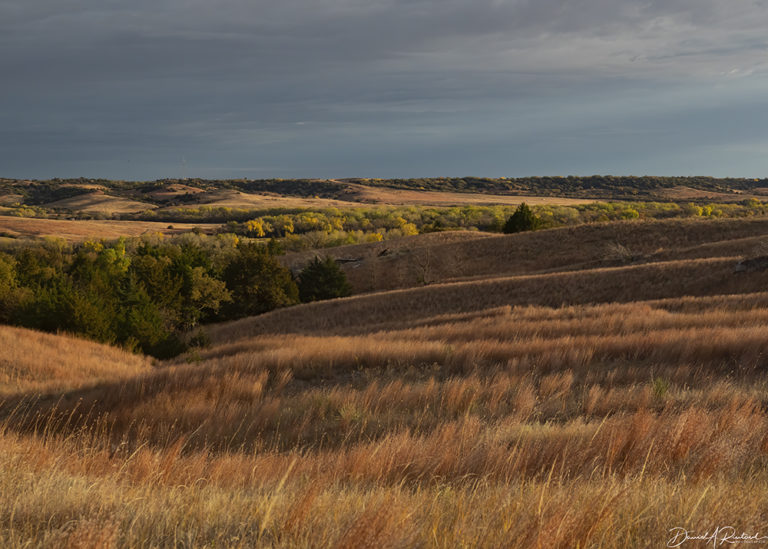
The dominant grass in this part of the Great Plains is Little Bluestem (Schizachyrium scoparium), a warm-season bunchgrass that turns color after the first frost. These shades of copper, crimson, and russet make dawn and dusk in this landscape especially luminous.
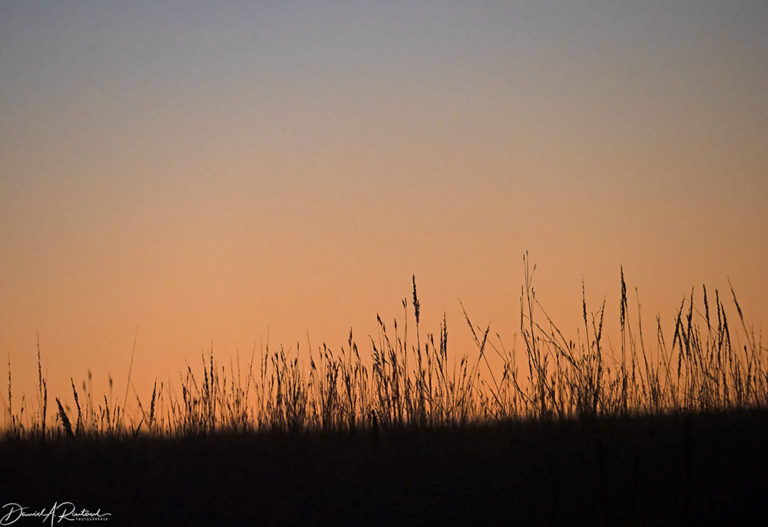
Grasses silhouetted in the pre-dawn light. Mostly Indian Grass (Sorghastrum nutans) and Little Bluestem, but there is at least one seed head of Big Bluestem (Andropogon gerardii) in this image as well.
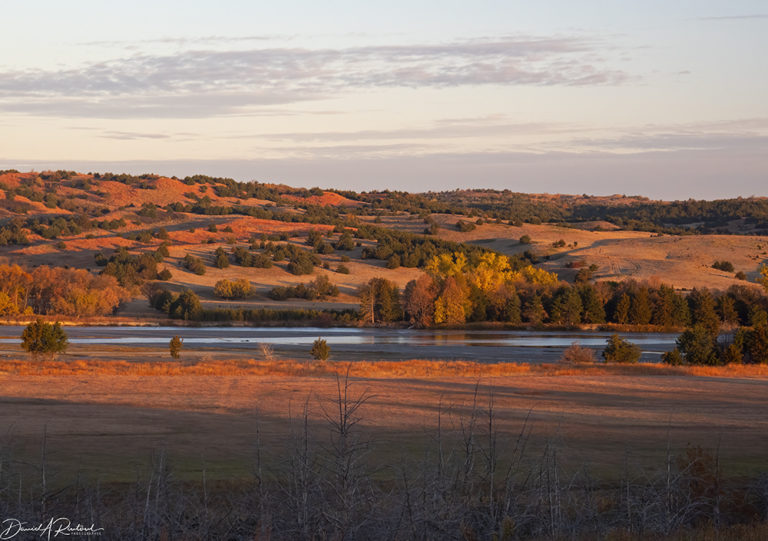
The sanctuary is located on the south side of the Niobrara River, seen in this image. That wet meadow between the photographer and the river hosts a pair of Sandhill Cranes in the summer; this last summer they raised one baby and headed south in the early fall. Hopefully they will be back and raising more babies next spring.
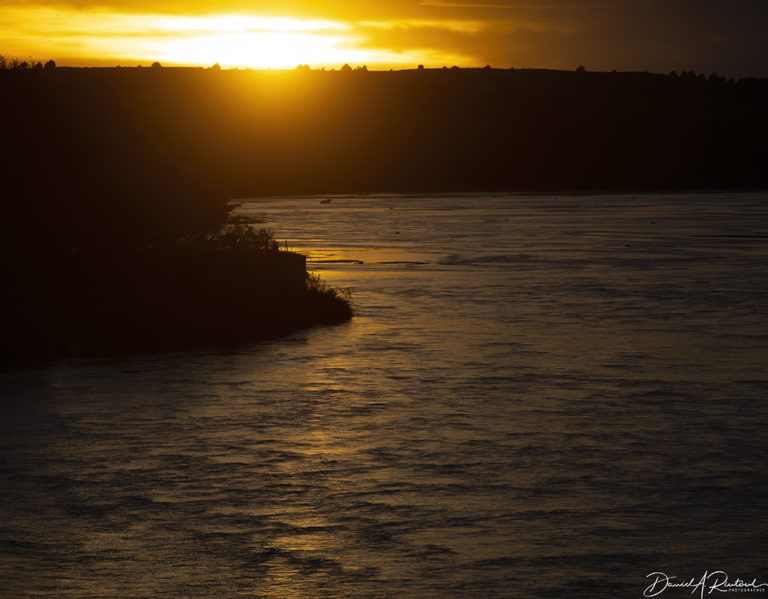
The fires in the west were still coloring the skies at dawn and dusk, putting a coppery overlay on the Niobrara River in this sunset scene.
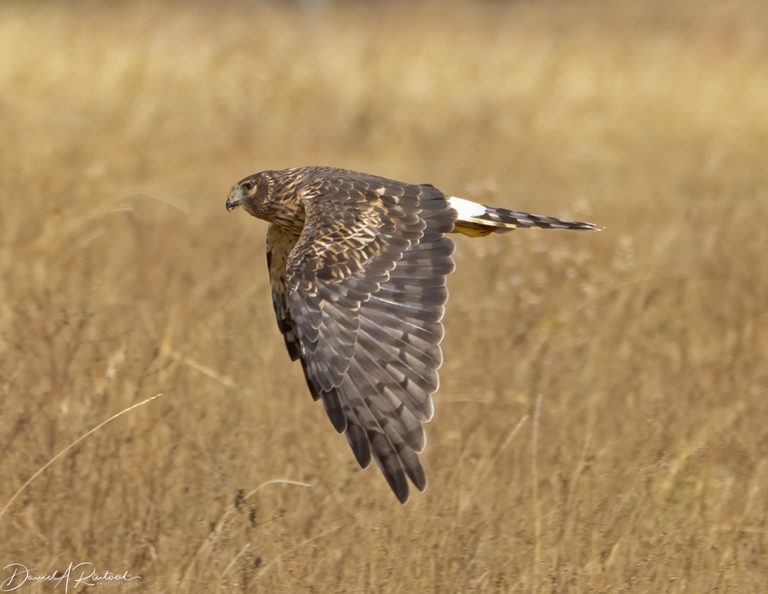
By mid-October a lot of the waterfowl and summer sparrows had left the Sandhills, but there were still birds to see. This female Northern Harrier (Circus hudsonius) was patrolling a prairie not far from the sanctuary. You can see that there are still some remnants of her last meal on her beak; she needed a napkin but the offer was refused.
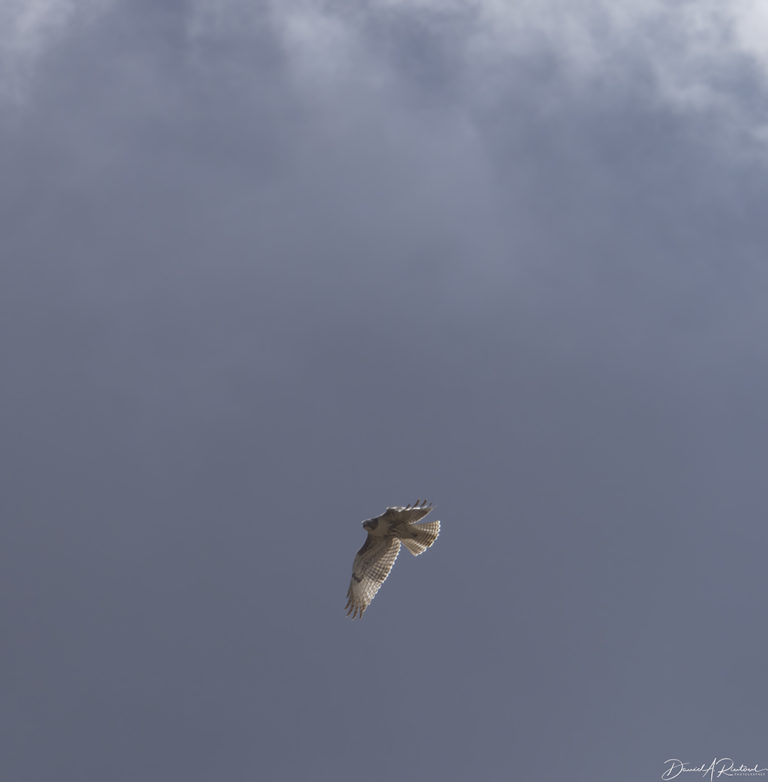
The skies are endlessly changing in the Sandhills at this time of year, but one constant is that they are often patrolled by Red-tailed Hawks (Buteo jamaicensis). This young bird, perhaps a migrant, was circling higher as higher as I watched it, but there will be Red-tailed Hawks here throughout the winter.
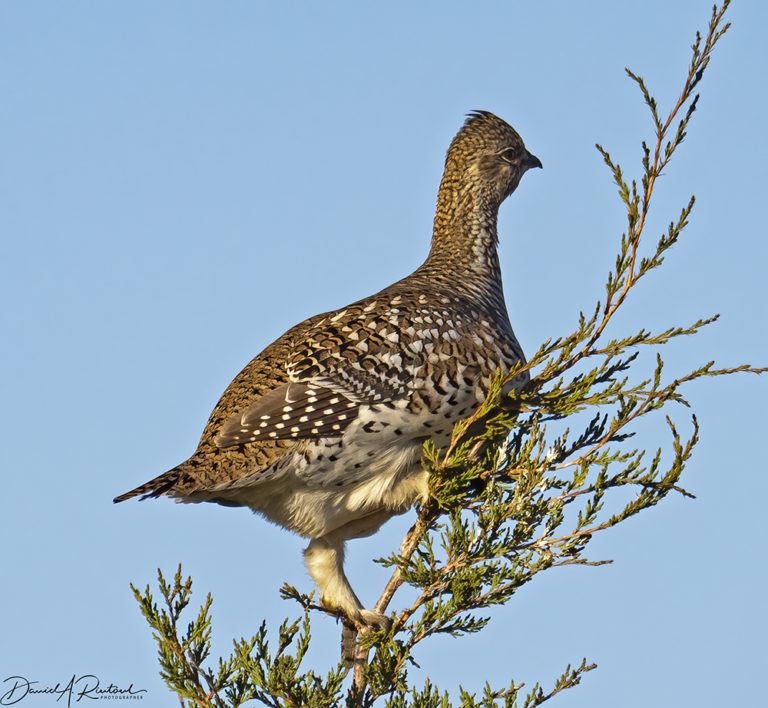
One of the iconic Great Plains birds that birders head to the Sandhills to see (yes, birders do things like that) is the Sharp-tailed Grouse (Tympanuchus phasianellus). There is apparently a lek just across the road from the guesthouse where one can see a dozen or more birds displaying and fussing each spring. This one found its way to the top of an Eastern Red Cedar and used it as a lookout perch. Check out those legs, feathered almost to the toes, which is probably very helpful in getting through a winter here.
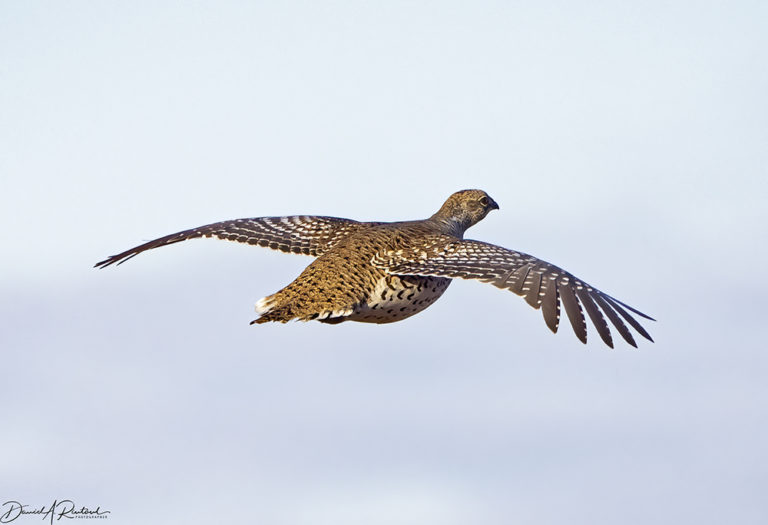
Sharp-tailed Grouse in flight, showing off those white-spotted wings and beautiful, yet cryptically-colored, back plumage.

JeanneT
You make me yearn for the open skies of the prairie states. And a coffee table sized book of your photos!
Mary G
What a beautiful landscape and birds.
OzarkHillbilly
This is rather apt for me. My oldest is planning on climbing Devil’s Tower in May. Dawg willing and the Covid don’t rise, I intend to watch him do it.* I was looking at maps just last week for a blue highway route to take and one of the things to catch my eye was the Niobrara National Scenic River and I was thinking of following it into WY. The likelihood of this just went up another notch or 2.
*35 years ago I stopped at DT with the family and watched folks climbing it. All I could think was, “I want to do that.” and swore I would. Even bought a book showing the various routes up. But life happened and I never got there. I’ll be damned if I’m going to miss seeing my son do something I had once dreamed of.
JPL
The photos are beautiful.
Amir Khalid
@OzarkHillbilly:
Having seen more than one cut of CE3K, I actually know of Devil’s Tower.
Wag
Spectacular, as always. Thanks. The Sandhills are a haunting landscape.
Albatrossity
@OzarkHillbilly: Yeah, there are worse routes across Nebraska than a northerly one that tracks along the Niobrara and through the Sandhills. Sounds like a fun trip, and I hope that your son has a successful climb!
debbie
The landscapes! The Midwest doesn’t get enough credit for its beauty.
scribbler
I’ve been lucky enough to visit the Rowe Sanctuary near Kearney twice for springtime migration. Both visits were magical and unworldly with the sounds and sights of thousands of visiting sandhills. I hope to see it again, if not this spring, than next!
DonL140
Again, so impressed with your skills. Just beautiful.
Albatrossity
@scribbler: Yes, the migration spectacle of Sandhill Cranes (and geese and ducks!) along the Platte in March is incredible. Be warned, however, that once you see that, you (just like the cranes) will want to get back there every spring. It’s a four-hour drive for us here, and we have been up there for North America’s last great migratory gathering many times. We had plans, but COVID intervened and we didn’t make it in 2020, probably won’t make it in 2021 yet, but we will get there again too!
Mathguy
Fabulous photos! I’ve lived in Nebraska most of my life (grew up in Lincoln) and still have not traveled out to the Sandhills. Yes, I am an idiot.
Dagaetch
Magnificent. Thank you for sharing!
Nelle
My reward for writing my Master’s exams at University of Nebraska in 1976, was an angled drive from Lincoln, through the Sandhills, up to Fort Robinson. I felt the need to stand on the site of the murder of Crazy Horse, to mourn and honor all those lost in the westward thrust of what is now the American myth (probably was then too). The rich scent of fallen cottonwood leaves has stayed with me and even now, I have a small twig of dried cottonwood leaves on the bookcase of my most important books. (I went in the second week of November.)
Have I missed the link as to where you sell your photos?
cope
Beautiful pictures from the prairies, thanks.
In high school in the Chicago suburbs in the ’60s, I had a biology teacher who loved botany. She used to march us out to a place on our school campus, out past the parking lot in back, near the dumpsters where she claimed she had found a tiny triangular plot of virgin prairie. She took us on these little field trips throughout the school year to see how the plants changed with the seasons. I bring this up because the only two plants I can remember her showing us were the big bluestem and little bluestem varieties of prairie grass. Your mention of little bluestem triggered these memories.
I will never know for certain that that small pie-shaped bit of land really was virgin prairie but it sure gave her an immense amount of pleasure to believe so and share her knowledge with us.
Princess Leia
Your photos have been one of the saving graces of these months. Thank you for sharing the beauty, but also something about the bird or landscape that brings them alive. It’s like getting to walk quietly beside you. A real gift!
JanieM
What a great way to start the day. I didn’t have to get beyond the first picture to readjust from already-frazzled to ah, it will all get done.
Though I’ve driven across Kansas and Nebraska on the way to various (mostly mountainous) hiking destinations, I’ve never stopped to spend time along the way. Here goes another place onto the list.
Albatrossity
@Nelle: Yes, the scent of a fall cottonwood grove is a treasure, at least for me. I’m glad that others find that to be true as well!
Fort Robinson is indeed a place that folks need to visit. A sad history haunts most of the Great Plains, and we must never forget it.
As for selling photos, indeed there is a site. Just click on my name above this comment, or click here to be taken to my portfolio site. There are also links to buy some 2021 photo calendars, one of landscapes and one of birds. Indeed, some of the landscapes from our trips to Nebraska this year have made the cut and were included in that landscape photo calendar.
Albatrossity
@cope: Wow, great story. Yes, Illinois, the “Prairie State” according to its PR department, has very little prairie left amid the corn and soybean row crops. These remnants are mostly railroad right-of-ways, cemeteries, and out of the way small plots like the one you describe. There are some fabulous restored prairies in that state, but we know that prairie ecosystems take decades or centuries to establish…
There go two miscreants
Very nice; I especially like the ones taken with a low Sun angle. Thanks for posting these.
bluefoot
@OzarkHillbilly: Going to see Devil’s Tower is on my bucket list. I should start planning that…not getting any younger. :)
cope
@Albatrossity: One of the other things I remember is how she had us use our hands to dig deep down into the substrate to see how the roots of all the plants were so thoroughly intertwined. This was one of the things that convinced her it was virgin.
As I recall, the plot was locked behind a bit of chain link around some power poles or such. However, any and all memories not guaranteed.
arrieve
A wonderful start to the day. Thank you, Albatrossity.
I’m seeing a cross-country road trip in my future. I’ve been to all seven continents, but there’s so much of this country I still haven’t seen. And you’ve made the Midwest top of the list.
Spanky
We used North Platte as our base for the August 2017 eclipse, traveling a bit north to Stapleton, which was cut by the eclipse centerline. After all the hoopla was done, we headed north for Rapid City, SD. Had to periodically stop in the Sand Hills to admire the scenery, as well as a too-brief stop and hike in Valentine NWR. Unfortunately, not a lot going on wildlife-wise during the high-sun hours in August. We both would like to go back sometime, and October looks perfect.
MazeDancer
Had no idea Nebraska was so beautiful. Thanks for bringing us the photos.
Mike S (Now with a Democratic Congressperson!)
Wonderful! Sometime I need to come out there and see those STGr!
JustRuss
Such wonderful pics. The light hitting the underside of the red-tail is just sublime.
joel hanes
@cope:
If that triangular bit of land was fenced, it might never have been plow-broken, nor often mowed.
Plows and mowers have difficulty getting into corners bounded by acute angles. (Many native prairie plants will tolerate occasional mowing, but as perennials, they are doomed by plowing)
In the chapter of Leopold’s wonderful A Sand County Almanac* that discusses the compass plant, Silphium laciniatum, which does not tolerate plowing, he celebrates a lone specimen that persisted for years in an un-mowable corner of a country cemetary.
When I was growing up in Iowa, I never saw a compass plant. Since then, a native-prairie restoration movement has grown, and I often see several species of Silphium in nearby road-ditches. In a container next to the desk as I write this, I have some compass plant seed that I gathered this fall.
* If you like the pictures in this post, and have not yet read A Sand County Almanac, I urge you to read it, starting in January.
Albatrossity
@cope: Yeah, most of the biomass of a prairie is underground. If you ever get to Manhattan KS you should visit our Discovery Center, which has an excellent display of various tallgrass prairie plants, showing the depths of the roots in many of those.
Albatrossity
@Mike S (Now with a Democratic Congressperson!): Apparently there is a grouse lek just across the road from the Hutton Ranch guest house where we stayed. If you time it right in April (and NE weather is notoriously unpredictable in the spring) you should be able to hear them from the house, and maybe photograph them without seriously inconveniencing any morning routines!
joel hanes
@Albatrossity:
Reciprocally, if you have not yet visited the Neal Smith National Wildlife Refuge south of Prairie City IA (a few miles east of Des Moines off interstate 80), you should do so. Excellent visitor’s center and vigorous ongoing research and restoration. A drive-through section has a small herd of genetically-pure American bison.
https://www.fws.gov/refuge/neal_smith/
Madeleine
I’ve sent these photos off to a close friend who lives in Omaha (grew up in Beatrice). They will make her happy, I think.
Albatrossity
@arrieve: Most US citizens have not seen much of Flyover Country; they call it that for a reason!
If you find yourself out this way, I’d be happy to show you around the Konza Prairie, 8600 acres of tallgrass, with bison thrown in for good measure. It is a Nature Conservancy property, and the site of a biological research station which is operated by folks in the KSU Division of Biology, the department that I retired from a few years back.
Albatrossity
@joel hanes: I have visited there, but only briefly. Sounds like I need to make a longer visit. Thanks!
And the mention of silphium always reminds me of my favorite line from Sand County Almanac – “What a thousand acres of Silphiums looked like when they tickled the bellies of the buffalo is a question never again to be answered, and perhaps not even asked.”
cope
@joel hanes: I have absolutely read “Sand County Almanac” though not since college days. One of my geology profs (my major) initiated an environmental geology course around ’69 or ’70 when I was an undergrad and that topped the reading list.
Now that you mention compass plant, I am sensing vague stirrings of memory that that was one of the other plants my HS teacher showed us on that hallowed ground.
cope
@Albatrossity: I had a friend who lived (and probably still does) in Tonganaxie so I have a bit of familiarity with that part of the country. I would stop to visit on my frequent trips back and forth from Illinois (college, grad school) to Colorado after my family moved there. She and I fell out of touch when I married and had children but I have fond memories.
joel hanes
@cope:
If you visit during a non-pandemic summer, I can recommend the breaded pork tenderloin sandwich at Goldie’s Drive-In in Prairie City — famous for the tenderloin itself being almost as big as your head. Good place for an ice cream on a hot day. More outside picnic-table seating than indoor, and a fine view of the truly enormous grain elevator complex adjoining the railroad.
I sure hope Goldie’s survives — so many beloved little family-operated businesses will be casualties of COVID and Republican unwillingness to provide effective relief measures …
cope
@joel hanes: Thanks for the recommendation. I have a fantasy trip in mind about driving from here in Florida to my family in Colorado with my two grandkids. I would want to drive up into Illinois first to hit some ancient haunts and then westward. Many stops along the way would be necessary and a good sandwich is always a reason to pull over.
joel hanes
@cope:
A deeply thoughtful book.
A Sand County Almanac repays re-reading, and the chapters get better and better as one goes along.
Yutsano
@Amir Khalid:
Excellent movie. Has one of the rarest pieces in the musical world: an oboe-tuba duet.
A woman from anywhere (formerly Mohagan)
Lovely and evocative pictures as always. Especially love the Sharp-tailed Grouse. I am getting more tuned in to the beauty and elegance of subtle markings, as you mentioned about the Grouse’s back. I have fallen in love with Gadwalls for the same reason.
Albatrossity
@A woman from anywhere (formerly Mohagan): Gadwalls are a very lovely, and underappreciated, duck. Many shorebirds have elegant but subtle patterns and color combinations as well.
There is something about feathers that they are endlessly fascinating, IMHO!
way2blue
Albatrossity, these autumn landscape photos are wonderful. I remain in awe of your photos of birds. Especially the ones in flight. Can’t imagine how you capture those images. Plus how you scope out where to photograph birds clinging to twigs, branches, and such…
sab
Realize that this is Nebraska not Kansas, but where are all those mountains we see on Gunsmoke reruns every week (Dodge City, Kansas.)
Albatrossity
@sab: Yeah, I grew up 50 mi west of Dodge City, and I always giggled at the sight of those canyons and mountains that were allegedly in that part of the country. And the occasional California Quail call in the background really didn’t help much either!
cope
Nebraska…sigh, my bad. I’m not sure how I got stuck in Kansas.
WaterGirl
@cope: Because Albatrossity lives in Kansas?